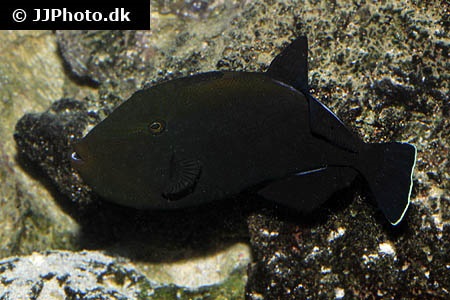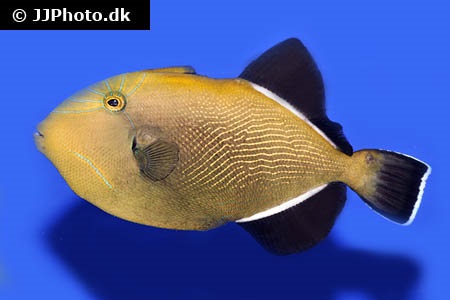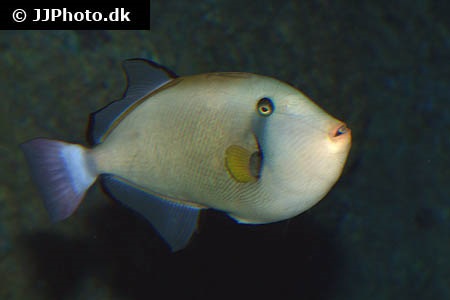Melichthys indicus
| Latin name | Melichthys indicus - Randall & Klausewitz, 1973 |
|---|---|
| Local name | Indian triggerfish |
| Family | Balistidae - Melichthys |
| Origin | East Indian Ocean, West Indian Ocean, Australia, Indonesia |
| Max length | 25 cm (9.8") |
| Minimum volume |
2000 l (528 gal) |
|---|---|
| Hardiness |
Average |
| Suitable for aquarium |
Suitable with care |
| Reef safe |
Reef safe with luck |
| Aggressiveness | Aggressive towards other species |
| Recommended |
Larger crustaceans (Shrimp, crabs...) Other invertebrates Small crustaceans (Krill, mysis, artemia...) |
|---|---|
| Mostly |
Large polyp stone coral (LPS) Soft coral |
| Maybee |
Small polyp stone coral (SPS) |
This spicies might be a threat to smaller fishes.
This species will eat shrimps, crabs, small bivalves, snails and the like.
This species some times likes to biting rubber and plastics etc, which are found in an aquarium.
Be aware of this, therefore place other objects in the tank which it will then examine as a natural food source.
This species can be extremely aggressive towards other fish.
Be careful when keeping these fish together with peaceful or docile species. Regular feeding, plenty of hiding places and a lot of space can alleviate aggressive behavior to some degree.
This species must be fed with an appropriately varied diet.
This species has a habit of rearranging rocks and sand.
Make sure rocks are placed securely on the substrate, so they cannot toppled over.
This fish requires feeding several times a day, especially when newly added.
When the fish can find its natural food in the aquarium it requires less frequent feeding.
These fish require food which helps to prevent overgrowing teeth. e.g. clams.
If their teeth grow too much, it might necessitate grinding them down, however this is a very stressful procedure.
This species needs good hiding places, for example, between live rocks.
This species revels in swimming and requires an aquarium with ample space.
Not as aggressive as many other Triggerfish, but do still be cautious.
Triggerfish (Balistidae) are distinguished by their strong jaws which are used for crushing rock, shells or corals in its hunt for food.
It is hard to give a general discription of Triggerfish, as they vary much in behaviour, not just between species, but also from specimen to specimen.
These fish are generally not reef safe and are a challenge to keep in a coral aquarium. Those that fit best, are the Melichthys, Odonus and Xanthichthys species as they live mostly of zooplankton. They will therefore often leave corals and for the most part crustaceans alone, if they are well fed. The more space available to these fish the smaller the problems tend to be.
These fish are generally very aggressive towards other fish, they should be given a lot of space to minimize their aggressivel behaviour. Generally speaking, it is difficult to find fish which live together with Triggerfish. It is obvious that small fish would fall victim to them, but also Lionfish, for example, would not survive the Triggerfish.
Triggerfish need a larger amount of food than many others, so it pays to be well prepared when acquiring them. At the same time it is important to provide a varied diet, consisting of krill, Mysis, shrimps, crabs, mussels, small fish, octopus, snails as well as algae based foods.
They have a great personality compared to other fish, some owners have taught their Triggerfish tricks using little titbits.
They have been known to swirl sand about, in order to find food. They are also known to spray water from the surface, therefore care must be taken when placing electrical equipment.
One must also realize that they can sometimes bite fingers or arms, so one must take all precautions neccessary.
| Aquarium trade | Yes |
|---|---|
| Distribution | Indian Ocean: Red Sea and East Africa eastward to western Thailand and Sumatra, Indonesia. |
| Danish common names |
Indisk aftrækkerfisk |
| English common names |
Indian triggerfish Black finned triggerfish Black triggerfish |
| German common names |
Indischer Drückerfisch |
| French common names |
Baliste à nageoires noires Baliste indien |
David A. Crandall. 2002. Triggerfishes - Reefkeeping Magazine - (English)
Jim McDavid. 2007. Aquarium Fish: Triggerfish - Advanced Aquarist - (English)
Bob Fenner. Bruisers and Cruisers, the Triggerfishes, Family Balistidae - Wet Web Media - (English)
Scott W. Michael. Reef Aquarium Fishes: 500+ Essential-to-know Species - TFH Publications / Microcosm Ltd. - (English)




